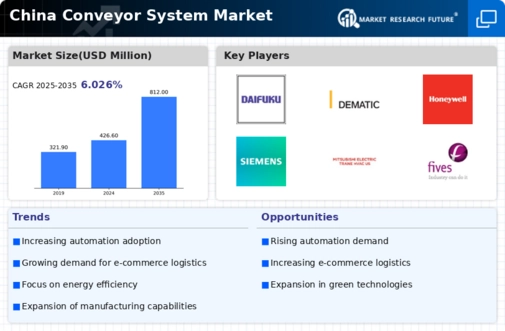Focus on Supply Chain Resilience
The emphasis on supply chain resilience in China is emerging as a key driver for the conveyor system market. Recent disruptions have highlighted the need for robust logistics solutions that can adapt to changing conditions. Companies are increasingly recognizing the importance of flexible and efficient material handling systems to ensure continuity in operations. In 2025, it is anticipated that investments in supply chain resilience will account for about 15% of the total expenditure in the conveyor system market. This focus on resilience is likely to lead to a greater adoption of automated conveyor systems, which can enhance responsiveness and reduce lead times. As businesses strive to build more resilient supply chains, the conveyor system market is expected to experience sustained growth, reflecting the evolving priorities of the industry.
Government Initiatives and Investments
Government initiatives in China aimed at boosting manufacturing and infrastructure development are playing a crucial role in the conveyor system market. Policies promoting automation and modernization of factories are encouraging businesses to invest in advanced conveyor systems. In 2025, government funding for industrial upgrades is projected to reach approximately $10 billion, with a significant portion allocated to enhancing material handling capabilities. These initiatives are likely to stimulate demand for conveyor systems, as companies seek to comply with new standards and improve productivity. The conveyor system market is expected to benefit from these investments, as they align with the broader goals of increasing efficiency and competitiveness in the manufacturing sector. This supportive environment suggests a favorable outlook for the market in the coming years.
Rising Demand from the Automotive Sector
The automotive sector in China is a significant driver for the conveyor system market. With the country being the largest automobile manufacturer, the need for efficient material handling systems is paramount. Conveyor systems are essential for assembly lines, facilitating the smooth movement of components and finished products. In 2025, automotive is expected to contribute approximately 25% of the total demand for conveyor systems. This demand is fueled by the increasing production of electric vehicles (EVs), which require specialized assembly processes. As manufacturers strive for higher efficiency and lower production costs, the adoption of advanced conveyor systems is likely to accelerate. Consequently, the conveyor system market is poised for substantial growth, reflecting the automotive sector's evolving landscape.
Technological Advancements in Conveyor Systems
The conveyor system market in China is experiencing a surge due to rapid technological advancements. Innovations such as smart conveyor systems equipped with IoT capabilities are enhancing operational efficiency. These systems allow for real-time monitoring and predictive maintenance, which can reduce downtime by up to 30%. Furthermore, the integration of AI and machine learning is optimizing the sorting and distribution processes, making them more efficient. As industries increasingly adopt these technologies, the demand for advanced conveyor systems is likely to rise. The market is projected to grow at a CAGR of 8% from 2025 to 2030, driven by these technological improvements. This trend indicates a shift towards more automated and intelligent solutions within the conveyor system market, positioning China as a leader in manufacturing innovation.
Expansion of Warehousing and Distribution Centers
The expansion of warehousing and distribution centers in China is significantly impacting the conveyor system market. As e-commerce continues to thrive, companies are investing heavily in logistics infrastructure to meet consumer demands. In 2025, it is estimated that the warehousing sector will account for around 30% of the conveyor system market. This growth is driven by the need for efficient order fulfillment and inventory management. Automated conveyor systems are becoming integral to these facilities, enhancing speed and accuracy in sorting and shipping processes. The increasing focus on reducing operational costs while improving service levels suggests that the demand for conveyor systems will continue to rise. This trend indicates a robust future for the conveyor system market, particularly in the context of logistics and supply chain optimization.
























Leave a Comment